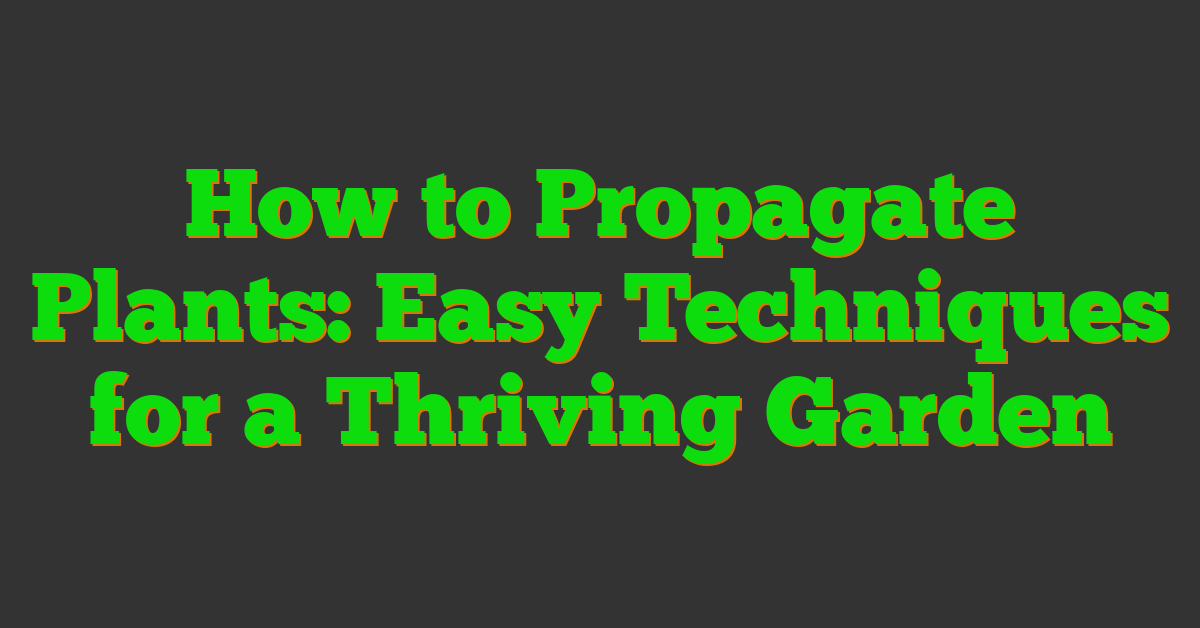Gardening has always been a passion of mine, and there’s something truly satisfying about multiplying your favorite plants. Whether you’re a seasoned green thumb or just starting out, propagation is a fantastic way to expand your garden without breaking the bank. It’s easier than you might think, and I’m excited to share some simple techniques that anyone can try.
Understanding Plant Propagation
Propagating plants allows me to expand my garden efficiently. It involves creating new plants from existing ones using different techniques.
Sexual vs. Asexual Methods
Sexual propagation uses seeds, combining genetic material from two parent plants. It ensures genetic diversity, enhancing disease resistance and adaptability. Asexual propagation clones a single parent through cuttings, layering, or division. This method produces plants identical to the parent, maintaining specific traits.
Benefits of Propagating Your Own Plants
Propagating your own plants saves money by reducing the need to buy new ones. It ensures control over plant quality and selection, resulting in healthier specimens. Additionally, it fosters a deeper connection with your garden as you nurture plants from their earliest stages. For example, cloning a favorite houseplant guarantees you always have a backup.
Essential Tools and Materials
I rely on specific tools and materials to successfully propagate plants. Having these items ensures each propagation method proceeds smoothly.
- Sharp Pruning Shears: I use these to make clean, precise cuts, minimizing damage to the parent plant.
- Rooting Hormone: I apply this to cuttings to promote quicker and stronger root development.
- Clean Containers: I choose containers with drainage holes to prevent waterlogging and support healthy root growth.
- Quality Potting Mix: I select a well-draining mix tailored to the plant type, providing the necessary nutrients and aeration.
- Watering Can: I use a watering can with a fine nozzle to gently moisten the soil without disturbing the cuttings.
- Plastic Bags or Cloche: I cover propagating plants with these to maintain humidity, creating an ideal environment for root formation.
- Labels and Marker: I mark each container with the plant type and propagation date to keep track of progress and care requirements.
Having these essential tools and materials on hand allows me to efficiently propagate a variety of plants, ensuring their healthy growth and successful establishment in my garden.
Easy Propagation Techniques
Propagating plants is simple with the right techniques. Here are three easy methods you can try at home.
Stem Cuttings
Take a healthy stem from your parent plant. Use sharp pruning shears to make a clean 4-inch cut just below a leaf node. Remove the lower leaves, leaving two or three at the top. Dip the cut end in rooting hormone to encourage root growth. Place the cutting in a pot filled with moist potting mix. Cover it with a plastic bag to maintain humidity and keep it in a bright, indirect light area. Check the moisture regularly and wait for roots to develop, usually within a few weeks.
Leaf Cuttings
Select a healthy leaf from your plant. Gently remove the leaf from the stem, ensuring you get a clean base. Let the leaf dry for a few hours to prevent rot. Insert the base of the leaf into a tray of moist sand or potting mix. Place the tray in a warm spot with indirect light. Keep the medium consistently moist and watch for new growth, which indicates successful propagation. This method works well for plants like succulents and begonias.
Division
Choose a mature plant with multiple stems or clumps. Carefully dig it up from the garden or pot. Gently separate the plant into smaller sections, ensuring each division has roots and shoots. Use a clean knife or your hands to make the separation. Repot each division into its own container with fresh potting mix. Water them thoroughly and place them in a shaded area until they establish. Division is ideal for perennials and plants that naturally grow in clusters, such as hostas and ferns.
Caring for Your New Plants
Proper care ensures your newly propagated plants thrive. Start by placing them in a location with bright, indirect light. Direct sunlight can scorch delicate stems and leaves, while too little light slows growth. Maintain consistent moisture by watering when the top inch of soil feels dry. Avoid overwatering, which can lead to root rot.
Use a quality potting mix to provide essential nutrients and proper drainage. If needed, mix in perlite or vermiculite to enhance soil aeration. Maintain a temperature between 65°F and 75°F, ideal for most houseplants. Humidity levels around 50% support healthy leaf development; consider using a humidity tray or a room humidifier if necessary.
Fertilize your new plants once a month with a balanced, water-soluble fertilizer. Follow the package instructions to prevent nutrient burn. Monitor for pests regularly, such as spider mites or aphids, and treat infestations promptly with insecticidal soap or neem oil.
Label each plant with its propagation date and type to track growth progress. Rotate pots weekly to ensure even light exposure and balanced growth. As your plants establish roots and show new growth, gradually acclimate them to their permanent locations, adjusting light and watering routines as needed.
By following these care guidelines, your propagated plants will develop strong roots and vibrant foliage, enhancing your garden’s diversity and beauty.
Common Mistakes to Avoid
- Overwatering: Excess moisture leads to root rot and fungal issues. Keep the soil consistently moist but not waterlogged.
- Insufficient Light: Without enough light, cuttings fail to develop strong roots. Place them in bright, indirect sunlight to promote growth.
- Using Diseased Plants: Propagating from unhealthy plants spreads pests and diseases. Always select healthy, pest-free parent plants.
- Incorrect Timing: Propagating during unfavorable seasons reduces success rates. Choose spring or early summer when plants are actively growing.
- Inadequate Tools: Dull or dirty tools damage cuttings and introduce pathogens. Use sharp, sterilized pruning shears for clean cuts.
- Neglecting Humidity: Low humidity causes cuttings to dry out. Maintain a humid environment with plastic covers or humidity trays to support moisture retention.
- Improper Soil Mix: Using poor-quality or inappropriate soil hampers root development. Opt for a well-draining potting mix tailored to the specific plant type.
- Skipping Rooting Hormone: Not using rooting hormone can slow down root growth. Apply a suitable hormone to increase propagation success.
- Ignoring Plant Labels: Failing to label propagated plants leads to confusion. Clearly mark each plant with its type and propagation date for easy identification.
- Rushing Transplantation: Moving cuttings too soon stresses them and inhibits root stability. Wait until roots are well-established before transplanting to their permanent location.
Conclusion
Propagating plants has truly been a rewarding journey for me. Seeing new life grow from cuttings or divisions brings so much joy and satisfaction. It’s amazing how simple techniques can expand your garden and deepen your connection to nature. I encourage you to give these methods a try and watch your garden flourish. Happy propagating!

















